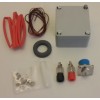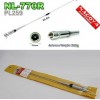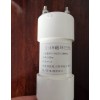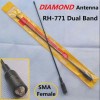Shopping Cart
0 item(s) - R0.00- 3D Printing and Plastic peripherals (8)
- 433Mhz and Lora (9)
-
Amateur Radio (651)
- - Antenna Analyzer (12)
- - APRS (12)
- - ATU (5)
- - CW (1)
- - Digital Modes (9)
- - DMR (4)
- - Echolink (10)
- - Enclosure (13)
- - Eshail-2 (QO-100) (67)
- - GPS (8)
- - iGate (1)
- - Microcontrollers (43)
- - Microphone (1)
- - Power Supply (7)
- - Programming Cable (6)
- - QRP (9)
- - Radio interface (21)
- - Receiver (9)
- - Repeater (4)
- - RF Amplifiers (20)
- - RF Kits (19)
- - RF modules (116)
- - Rotator (1)
- - SDR (75)
- - Spectrum Analyzer (4)
- - SWR (9)
- - Transceiver (59)
- - WSPR (5)
- Antennas and Acc (320)
- Audio and Video (28)
- Bargain Box (1)
- Battery (3)
- Bluetooth (11)
- Cables (37)
- Computer Peripherals (104)
- Connectors (90)
- Data acquisition (1)
- Display (2)
- Electromechanical (25)
- Enclosure (12)
- GPS (6)
- Hardware (3)
- Home Automation (128)
- Inverter (9)
- Liquid (7)
- Lora (8)
- Microcontrollers (119)
- Modbus (3)
- MQTT (14)
- Network Radio (3)
- Networking (8)
- Power (133)
- Power supply (49)
- Radio Interface (17)
- RF Modules (142)
- ROIP (2)
- Satellite (93)
- Security (13)
- Sensor (17)
- Solar (14)
- Test and Measurements (66)
- Tools and Equipment (8)
- VOIP (10)
- Weather (1)
1-30 MHz Balun Kit NXO-100 Toroid ring configurable for 1:1 1:4 and 1:9 impedance ratio, with SO 239 connector (KIT)
Ex Tax: R184.00
Add to Compare
1-30 MHz Balun Kit NXO-100 Toroid ring configurable for 1:1 1:4 and 1:9 impedance ratio, with SO 239 connector (KIT)

Specification:
- The circular models: NXO - 100
- Permeability: 100 ± 20
- Size: 31 * 18 * 7 (diameter * inner diameter * H) Unit: mm
- weight: 15 grams
- Material: nickel zinc ferrite
- It has good temperature stability, low loss characteristics. Such material is widely used, suitable for tuning inductance over a wide temperature range, various filtering, inductor devices such as RF segment
- Magnetic conductivity: 100
- Overall dimensions: outer diameter 31 mm * * height 7 mm diameter of 18 mm
- Center frequency: 15 MHZ
- Application frequency: 1-30 MHZ
This kit uses a low-permeability nickel zinc NXO-100 high-frequency ferrite toroid, high-quality wire, waterproof enclosure, stainless steel bolts, In the assembiling of the 1:1, 4:1, 9:1 balun you will use a large size NXO-100 magnetic ring and 1 mm diameter enameled wire. The Balun can be used for the frequency range 1-30MHz.( shortwave). The unit can withstand a maximum power of 100W-150W.
Types of Balun antennas matching configerations: 1:1, 1:4 and 1:9.
The 1:1 and 1:9 baluns is using three enameled wires and the 1:4 is using two enameled wire.
- 1:9 Balun suitable for long-wire antennas , with manual or automatic antenna tuner. (400-500Ω).
- 1:4 Balun applicable LOOP antenna or Winton antennas (200-400Ω).
- 1:1 Balun antenna suitable for bipolar Dipole (inverted V and V), such as Yagi antenna (40-100Ω).


1:1 Balun Assembly Diagram.

1:4 Voltage BALUN
Typically unbalanced = 50/75 ohms and balanced = 200/300 ohms.

1:4 Current Balun
Typically unbalanced = 50/75 ohms and balanced = 200/300 ohms.

1:4 Balun Assembly Diagram.

1:9 Unun Asembly for long wire termination.
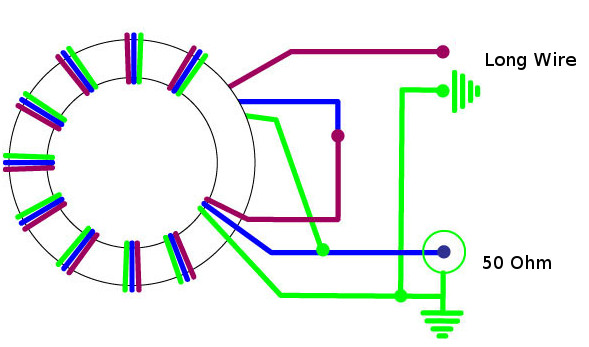
1:9 Balin Assembly Diagram.


Balun Kit Manual V2
The Balun principle is derived from basic antenna theory.
The dipole antenna is a balanced type antenna where the coaxial cable is a unbalanced transmission line. if the Dipole is directly connected to the coaxial cable it will course high frequency current flows in the shield of the Coaxial cable. According to the principle of coaxial cable, high-frequency current should flow within the center conductors of the cable, the skin is the shield and there should be no current.
If there is high curent on the shield / skin of the coaxial cable the cable will also radiate signal affecting the radiation pattern of the antenna. Therefore it is necessary to join the cable and the Dipole antenna with a balun. The current flowsing into the cable shield will now be eliminated with the Balun.
- 1:1 Balun applicable to Dipolar DP antennas (inverted V n V) Yagi antenna, etc. (40-100Ω).
- 1:4 Balun applicable to Loop antennas and antenna such as Winton (200-400Ω).
- 1:9 Balun antenna suitable for long-term, with manual or automatic antenna tuner tune day use.
This kit uses a large-sized high-quality nickel-zinc magnetic ring usable in the frequency range 1-30MHz and can withstand 100W-200W of RF power.
First Step
Select the impedance ratio balun according to the type of antenna you want to use. 1:1, 1:4, 1:9.
Winding the 1: 1 Balun.
- Three wires twisted around 7 times around the Feride core
Winding the 1:4 Balun
- Two wires around 8 times around the Feride core.
Winding the 1:9 Balun
- Three wires 10 times around the Feride core. (about 3-4 per cm Ci).
Tools required for assembly
- Solering iron
- Solder wire
- Side cutter
- Knive
- Wrench
- Multimeter
Here is a link to some ref dokumentation
Write a review
Your Name:Your Review: Note: HTML is not translated!
Rating: Bad Good
Enter the code in the box below:
Giga Technology © 2025




